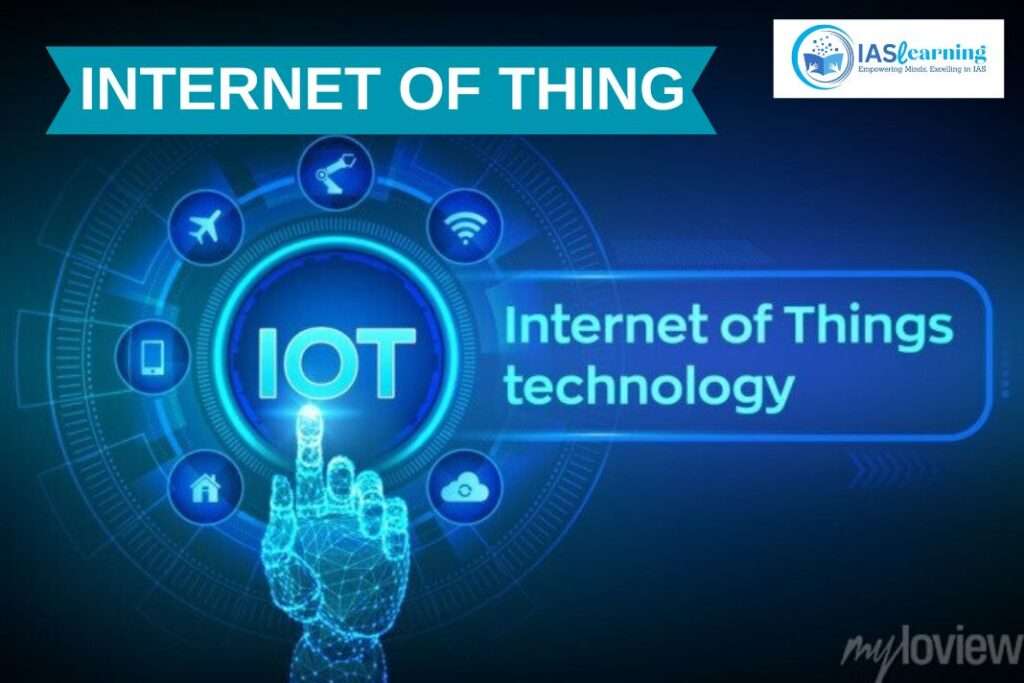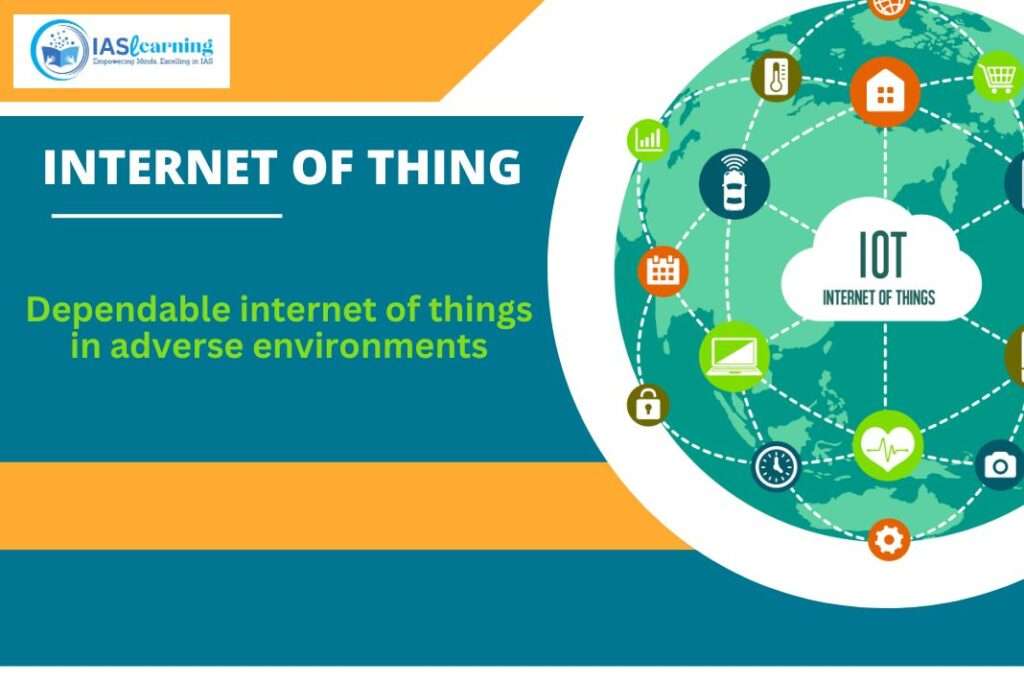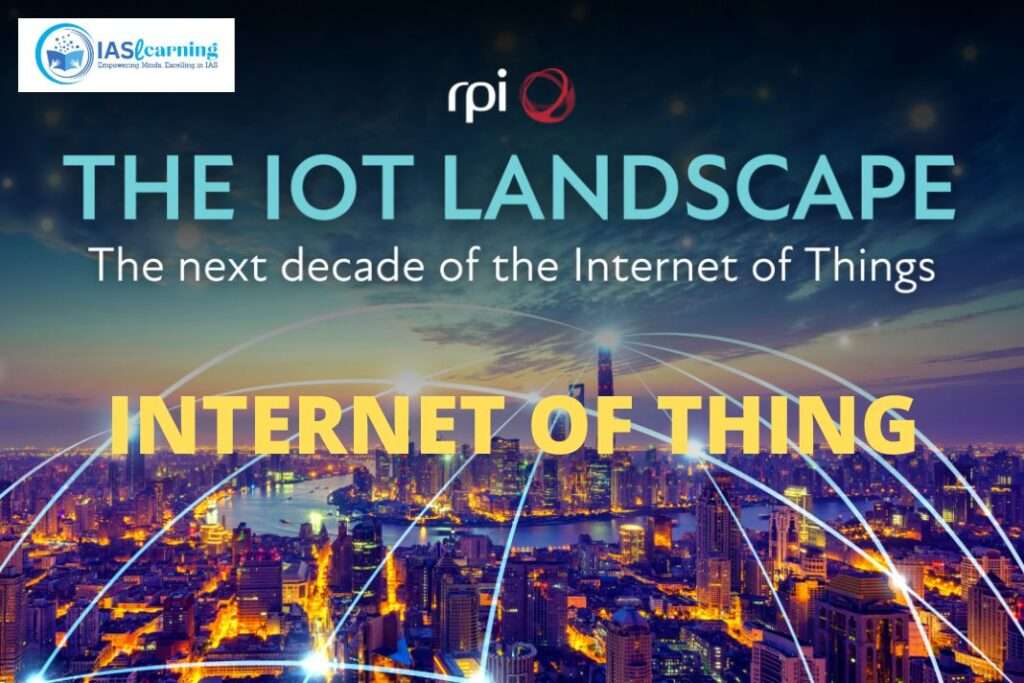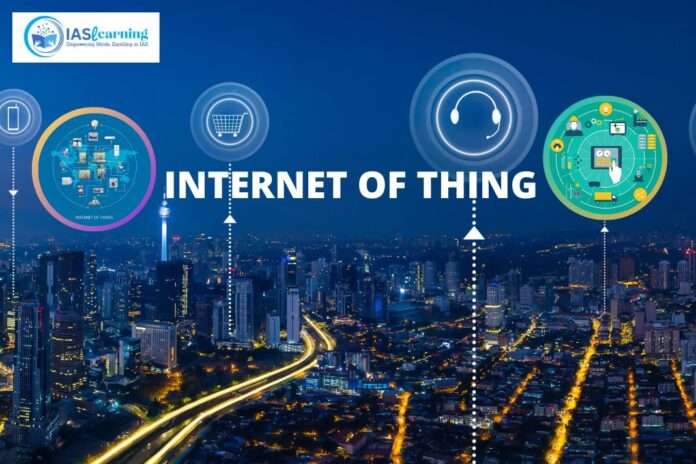Introduction to Internet of Things
- The Internet of Things (IoT) refers to a network of physical devices, vehicles, appliances and other physical objects that are embedded with sensors, software and network connectivity that allows them to collect and share data. These devices — also known as “smart objects” — can range from simple “smart home” devices like smart thermostats, to wearables like smartwatches and RFID-enabled clothing, to complex industrial machinery and transportation systems
- The Telecommunication Engineering Centre (TEC), under the Department of Telecommunications, Ministry of Communications, has published a report titled “Code of Practice for Securing Consumer Internet of Things (IoT)” as a minimum requirement in line with international standards and best practices for protecting IoT devices.
Internet of Things
- The idea of common physical things being connected to the internet and having the ability to recognize other devices is a computing concept.
- One of the fastest-evolving technologies in the world, it offers a wealth of options for society, business, and consumers.
- Using connected devices, it is being used to build smart infrastructure in a variety of industries, including power, automotive, safety & surveillance, remote health management, agriculture, smart homes, and smart cities.
- A context-aware electronic device called a “smart device” is one that can share data with other devices wirelessly or by connecting to them by cable.
- Additional Technologies: The Internet of Things (IoT) is benefited by recent developments in a number of technologies, including sensors, connectivity (cellular and non-cellular), AI/ML, cloud/edge computing, etc.
- The global IoT security market is anticipated to increase from USD 8.2 billion in 2018 to USD 35.2 billion by 2023, per a market research analysis from Markets and Markets.

Statistics
- By 2026, there may be 26.4 billion IoT devices operational worldwide, according to predictions. About 20% of this will focus on cellular technologies. IoT device ratio between consumers and businesses might be 45%:55%.
- According to projections, there will be roughly 11.4 billion consumer IoT devices and 13.3 billion commercial IoT devices worldwide by 2025, or close to 45% of all IoT devices.
Indian Context: Internet of Things
- As part of the Digital India Mission, the Indian government plans to use the Internet of Things (IoT).
- In order to develop and implement machine to machine (M2M) communication, 5G technology, IoT, and other technologies, the National Digital Communications Policy was introduced in 2018.
- Additionally, the government allowed 100% FDI in the communications industry. Additionally, this ought to support the growth of IoT in India.
- With a vision to develop linked and smart IoT-based systems for our nation’s economic, society, and environmental demands, the Government of India created a Draft IoT Policy in 2015. A effort to create 100 smart cities across the nation was started under this policy.
- A draft IoT policy for India was also issued by the Department of Electronics and Information Technology (DeiTY).

Internet of Things applications
- Industry: IoT can be utilized to improve productivity, decrease human error, and increase efficiency. Depending on how it is used, the effects of IoT may differ from industry to industry.
- Agriculture: By having improved weather forecasts, soil nutrient content, pest infestation, etc., IoT may be leveraged to boost overall productivity. With the use of clever techniques, it can assist make agriculture profitable by improving price discovery for farmers.
- Health: IoT can be used by medical professionals to remotely monitor patient health. Smart beds can identify the patient’s attempts to stand up, as well as any unusual behaviors. IoT can be used to create specialized sensors for elderly people. Wearable heart monitors can be used to track patients’ heartbeats, blood pressure, etc.
- Transportation: IoT can be utilized for driverless cars, traffic management, toll booths, and other systems. Additionally, it can be applied to fleet management, safety support, better logistics, etc.
- Media and advertising: Businesses can utilize IoT to analyze and forecast customer behavior, use target marketing to create more effective advertising and marketing campaigns, etc. Concepts from big data and data mining can be applied here.
- Smart Cities: We can improve urban living conditions with the help of the Internet of Things. Smart parking, Intelligent Transport Systems, Smart urban lighting, Waste Management, Smart City Maintenance, Tele-care, Citizen Safety, Smart Grid, Smart Energy, Water Management, etc. are some of the major components of a smart city. management of solid waste, intelligent power grids, intelligent energy management systems, etc.

- Government Policies and Services: The government can provide better services to its residents with the use of IoT.
- Smart Retail: IoT gives businesses the chance to connect with consumers and improve the in-store experience. IoT technologies and smartphone interaction can improve how well merchants service their customers.
- Energy Engagement: Power grids of the future will be extremely dependable in addition to being intelligent enough. Distributed energy systems will be possible thanks to smart grids’ ability to identify the causes of power outages more rapidly and at the level of each individual residence, such as adjacent solar panels.
Benefits of Internet of Things
- Unprecedented Connectivity: IoT data and insights from connected applications and devices provide enterprises the capacity to produce new products that are inventive and provide services more quickly than their rivals.
- Monitor Data: It allows us to determine the precise amount of supplies we need or the quality of the air in our homes. It can also provide additional data that was previously difficult to get. For instance, keeping track of product expiration dates will increase safety.
- Enhanced Productivity: Real-time data from IoT networks of intelligent and smart devices gives employees the knowledge they need to maximize their daily productivity and efficiency.
- Accessibility: Right now, practically anywhere can provide one with the necessary information in real-time. Only a smart device with an internet connection is required. As an illustration, let’s use Google Maps to check our location rather than approaching someone in person.
- Saving money is another key benefit of the Internet of Things. The Internet of Things has been widely accepted since the cost of the tagging and monitoring devices is less than the amount of money saved.
- Time Saving: When compared to traditional technology, smart machinery offers greater compatibility with both other devices and human labor. This results in shorter stage intervals and less interruption. Time can be saved using IoT. Almost everything can be done from the palm of our hands, including checking the most recent news during our daily commute, reading a blog about our favorite hobby, and making an online purchase.

Internet of Things-related difficulties
- IoT devices are expected to expand in number, thus it’s critical to make sure that the endpoints adhere to the required security and safety measures
- Cybersecurity Attack: The hacking of commonly used devices and networks would be bad for businesses, organizations, countries, and most importantly, people.Therefore, it is crucial to secure the entire IoT ecosystem, from devices to apps.
- In order to succeed in this market, linked IoT devices must have end-to-end security; otherwise, IoT would cease to exist.
- Privacy issues: In this data-driven future, there is increasing worry about the possibility of heightened government monitoring and the ensuing invasion of civil rights, as well as the repression of dissent or of marginalized communities.
- Cybersecurity Attack Repercussions: Potential repercussions of such attacks include:
- Critical infrastructure and services are interrupted and experience disruption.
- violation of privacy.
- losses in life, cash, time, money, possessions, health, and relationships, etc.
- national-scale disturbances, including civil unrest.
- Job Loss: Because of IoT in industries, skilled and semi-skilled jobs in the manufacturing and service sectors are lost. A big labor force can be attributed to India’s demographic dividend. To prevent the demographic dividend from becoming a demographic calamity, we must control this issue. Automation in the auto manufacturing industry may have a big negative impact on unemployment.
Guidelines for Consumer Internet of Things Security
- No universal default passwords: During device provisioning, all IoT device default passwords must be unique per device and/or require the user to select a password that complies with best practices.
- Manage Vulnerability Reports: As part of a vulnerability disclosure strategy, IoT developers should offer a specific public point of contact.
- Maintain Software Updates: IoT device software should be securely upgradable.
- Security parameters: In order to operate securely, IoT devices may need to hold security parameters such keys and credentials, certificates, device identity, etc.
- Securely communicate: According to the capabilities of the technology and the intended use of the device, security-sensitive data, including any remote management and control, should be encrypted in transit.
- Reduce Exposed Attack Surfaces: The ‘principle of least privilege’ should guide the operation of all devices and services. According to the Principle of Least Privilege, a subject should only be granted the privileges necessary for them to carry out their work.
- Personal Data: Any personal data that the device may gather or communicate should be safely stored.
- Make Systems Resilient: Where usage or other depending systems call for it, IoT devices and services should be constructed with resilience.
Way ahead
- Addressing Data Security Issues: While IoT technology is undoubtedly beneficial to people all over the world, it may also pose a risk to their privacy.
- IoT makers will need to create and maintain consumer trust in their products in order to handle this data privacy risk.
- The Data Protection Bill, 2019, is a step in the right way in this regard.
- Global Deliberation is Required: To maximize benefits from IoT while minimizing hazards, policymakers, device manufacturers, and law enforcement organizations should collaborate globally.
- Justice Srikrishna Committee: The Committee has suggested a number of rules for the protection of personal data, including the right of consumers to information, permission, and the option to ask businesses to delete their data.
- Read Morehttps://en.wikipedia.org/
- Dhttps://iaslearning.in/o follow us

